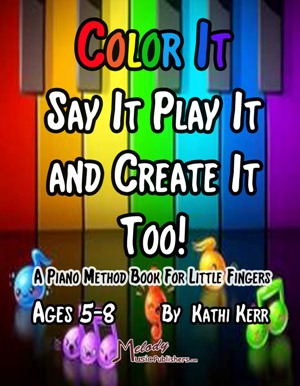Welcome the newest addition: “Color It Say It Play It and Create It Too”
“Color It Say It Play It and Create It Too” is the newest addition to Melody Music Publishers. This piano method book for children ages 5-8 is the sequel to “Color It Say It Play It and Create It.”. A student aged 7-8 can start with this book that may be too old for book 1. The beginning steps are taught, so no concepts are missing when starting with this book. It starts with technique, keyboard geography, and exercises, as in book 1. Then it moves onto playing hands together in the C hand position using letter names. As the book continues, it adds rhythm and big notes with the names and rhythm. And finally, the staff’s notes are introduced, starting with the treble clef and bass clef separately, then the grand staff. By the end, the student is playing songs with both hands in the C hand position. And for a bonus, the back of the book has Christmas songs arranged for any part of the book the student may be on at Christmastime.
Copycat Games
Copycat games are In the first few pages of the book. This game teaches the young student to “listen” and hear the notes being played. Listening to notes is a great learning skill and helps develop ear training. When a student is concentrating on reading while playing, it’s easy for a student of any age not to “hear” the notes. The first few songs in “Color It Say It Play It and Create It Too” are familiar songs with no title. The student plays the notes and has to figure out what the name of the song is. This exercise is fantastic to teach him or her how to listen while playing. The second skill learned with this game is creating a steady beat. When the teacher plays a set of notes with a steady beat, it allows the student to “copy” with the same steady beat, saying the note names aloud. And playing without looking at their hands is emphasized right from the beginning to create this good habit.
Why Start With Letter Names?
Most method books for the young beginner jump right into teaching notes on the staff. However, this skill requires the student to figure out the staff’s note name and then what key to play. Studies have shown that young children have difficulty with this process, and may cause them frustration. Thus, it may cause the student to cancel even before getting started. By starting with reading only the letter names, the young student can play more quickly and helps to develop dexterity in their playing. This book even includes exercises using the letter names, which I’ve never seen in piano method books for this age. The songs start with one hand at a time, then with hands together playing the same notes in each hand. Then the final step is playing different notes in each hand. The letter names go up and down, thereby teaching the concept of notes on a staff, without the student even being aware of it. I have found that a student can easily transition into reading notes on the staff after playing with letter names that ascend and descend.
Rhythm
The next step introduced is rhythm using drills and writing assignments. Rhythm is the element that is the most neglected in method books, especially for young students. However, I believe rhythm is the most critical aspect of playing and reading music. I’ve noticed that when the rhythm is emphasized early in the child’s lessons, they have no problem playing the rhythm correctly as they progress. I also emphasize a steady beat and counting, showing how each beat has a unique feel. There are rhythm drills in “Color It Say It Play It and Create It Too” that include clapping to a metronome on different beat numbers. Since rhythm is introduced in a clear yet fun way, it takes the guesswork out of it for the young student.
Combining Rhythm and Note Names
Once they are familiar with the rhythm, the next step is big notes with the rhythm and note names in the center. Once again, the notes ascend and descend to show the logic of the notes on a staff. The student is counting out loud while playing the various notes in the song. By now, the young student remembers where the keys are in their hand position so as to focus on the rhythm. Counting out loud and playing with a steady beat is emphasized, as well as not looking at their hands.
And Finally The Staff
The next and final step is introducing the staff. First, the treble clef notes are taught with worksheets and songs, then the bass clef, and finally, the grand staff. The note names are no longer given in the middle of the note. The first few songs on the grand staff start with both hands playing C to focus on the rhythm. Then the grand staff with random notes but the same notes in each hand with whole notes, then half notes, dotted half notes, and quarter notes. The last and final step is hands playing different notes in each hand, and all the rhythm taught.
Watch Video With Commentary
Songs in “Color It Say It Play It and Create It Too”
All the songs except two (“Ode to Joy” and “Pop Goes the Weasel”) are original songs. The purpose in writing the songs is to make sure the student is actually reading. While ear training is critical and included in this book, when playing songs, the skill of reading is most important. I wrote the songs to sound fun, so the student will enjoy playing and learning them. Learning to read music also teaches the concept that reading is essential to playing songs they may not be familiar with.
The Next Step
This book helps the young student to smoothly transition into our “Drill & Excel On the Piano” series. All the important concepts are taught. Students seven or eight can continue with “Drill & Excel On the Piano Book 2” which starts with both hands in the C hand position. If the student is seven or younger, I recommend starting with “Drill & Excel On the Piano Book 1”.
Thank You For Choosing “Color It Say It Play It and Create It Too”
I appreciate all teachers that order books at Melody Music Publishers. Remember to register if you haven’t already to receive discount codes for free shipping and 50% off your first copy. Then when ordering for your students, you’ll receive free shipping and 20% off all future orders. I wrote these books from my own experience teaching this age group how they think and learn. My hope is the young student will be excited about learning to play the piano and are given the steps needed to succeed for a lifetime. Thank you for doing the best job in the world, sharing your joy and passion for music with others.

Kathi Kerr founded Melody Music Studios in 1989, a nationwide music instruction studio. In 2017, she founded an independent publishing company called Melody Music Publishers. They offer piano and singing method books using small steps and repetition, how students think and learn.

